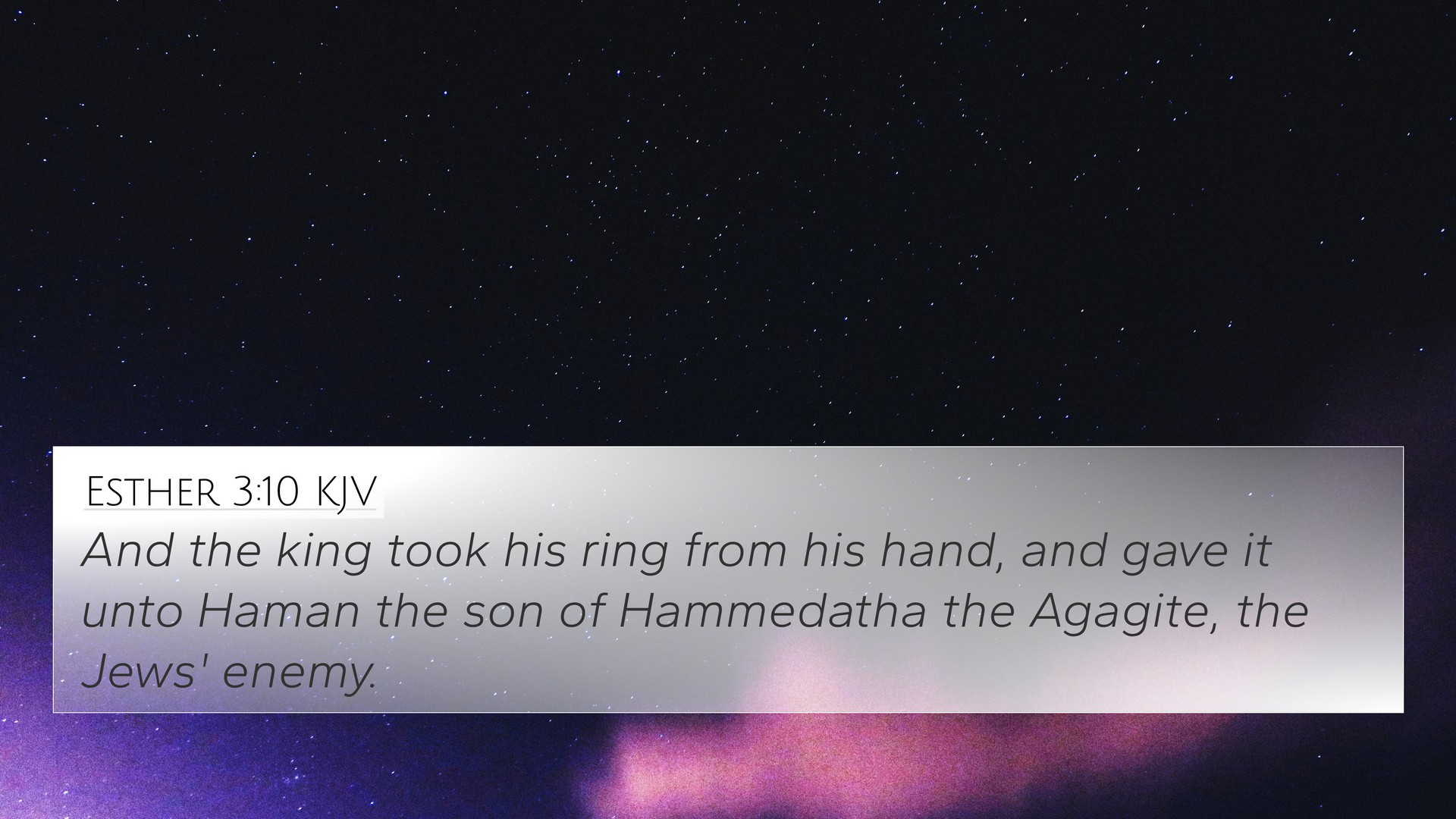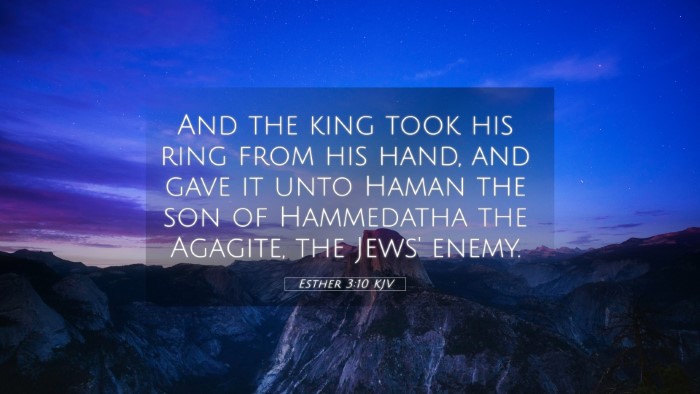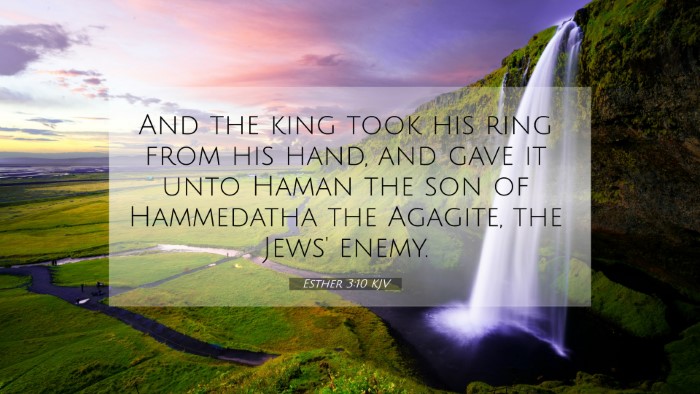Old Testament
Genesis Exodus Leviticus Numbers Deuteronomy Joshua Judges Ruth 1 Samuel 2 Samuel 1 Kings 2 Kings 1 Chronicles 2 Chronicles Ezra Nehemiah Esther Job Psalms Proverbs Ecclesiastes Song of Solomon Isaiah Jeremiah Lamentations Ezekiel Daniel Hosea Joel Amos Obadiah Jonah Micah Nahum Habakkuk Zephaniah Haggai Zechariah MalachiEsther 3:10 Similar Verses
Esther 3:10 Cross References
And the king took his ring from his hand, and gave it unto Haman the son of Hammedatha the Agagite, the Jews' enemy.
Uncover the Rich Themes and Topics of This Bible Verse
Listed below are the Bible themes associated with Esther 3:10. We invite you to explore each theme to gain deeper insights into the Scriptures.
Esther 3:10 Cross Reference Verses
This section features a detailed cross-reference designed to enrich your understanding of the Scriptures. Below, you will find carefully selected verses that echo the themes and teachings related to Esther 3:10 KJV. Click on any image to explore detailed analyses of related Bible verses and uncover deeper theological insights.

Genesis 41:42 (KJV) »
And Pharaoh took off his ring from his hand, and put it upon Joseph's hand, and arrayed him in vestures of fine linen, and put a gold chain about his neck;
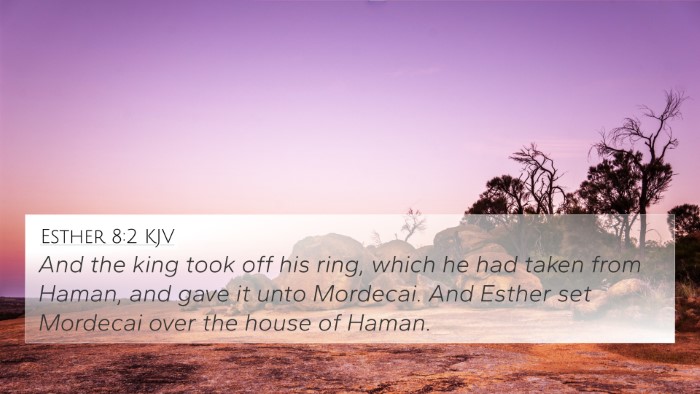
Esther 8:2 (KJV) »
And the king took off his ring, which he had taken from Haman, and gave it unto Mordecai. And Esther set Mordecai over the house of Haman.
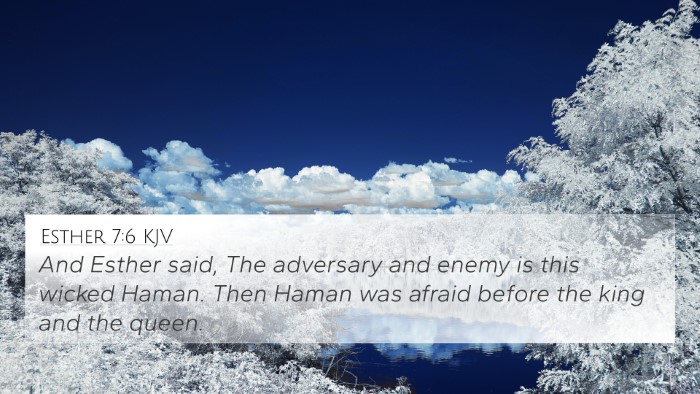
Esther 7:6 (KJV) »
And Esther said, The adversary and enemy is this wicked Haman. Then Haman was afraid before the king and the queen.
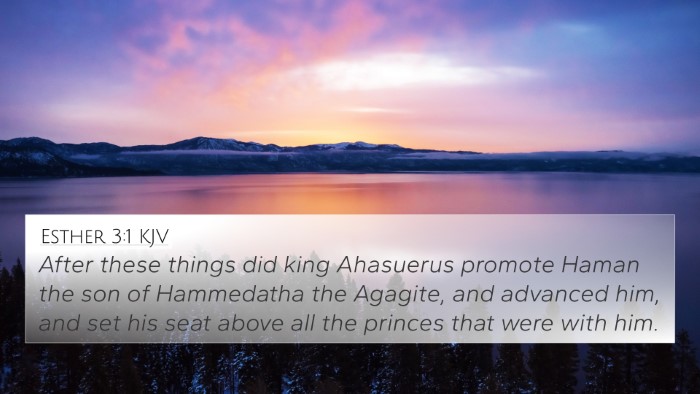
Esther 3:1 (KJV) »
After these things did king Ahasuerus promote Haman the son of Hammedatha the Agagite, and advanced him, and set his seat above all the princes that were with him.
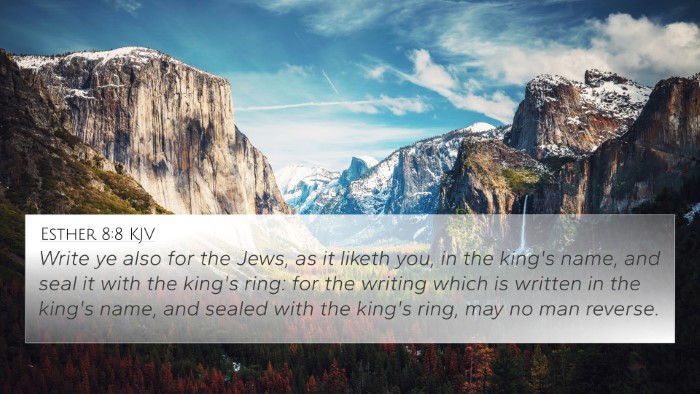
Esther 8:8 (KJV) »
Write ye also for the Jews, as it liketh you, in the king's name, and seal it with the king's ring: for the writing which is written in the king's name, and sealed with the king's ring, may no man reverse.
Esther 3:10 Verse Analysis and Similar Verses
Understanding Esther 3:10
The verse Esther 3:10 states, "And the king took his signet ring from his hand and gave it to Haman the son of Hammedatha the Agagite, the enemy of the Jews." This verse marks a significant turning point in the narrative of Esther, showcasing the authority given to Haman and the impending crisis for the Jewish people. This summary explores its meaning and implications through the insights gathered from notable public domain commentaries.
Historical Context
This verse occurs in the context of the Persian Empire, where Esther, a Jewish woman, becomes queen. Haman is a high-ranking official who harbors deep hatred toward the Jews, primarily due to Mordecai's refusal to bow down to him. This animosity sets the stage for a decree that threatens the existence of the Jewish people.
Commentary Insights
- Matthew Henry: Henry emphasizes the gravity of Haman's rise to power and the significance of the king's signet ring as a symbol of authority. By giving Haman this symbol, the king unintentionally paves the way for the plot against the Jews.
- Albert Barnes: Barnes notes that the granting of authority to Haman illustrates the ease with which power can corrupt and lead to the suffering of innocents. The mention of Haman being an "enemy of the Jews" highlights the collective fate that rests on communal discrimination.
- Adam Clarke: Clarke provides additional insight into Haman's lineage, identifying him as an Agagite. This is significant as it ties Haman's animosity towards the Jews back to historical enmity established during the times of Saul, suggesting a long-standing conflict.
Thematic Connections
The themes present in Esther 3:10 resonate throughout scripture, illustrating the dangers of unchecked power, prejudice, and the survival of God's chosen people.
- Power and Corruption: The verse reflects the corrupting nature of power, similar to Bible verse cross-references in 1 Samuel 15:10-23, which discusses the downfall of King Saul due to disobedience.
- Enemy of God’s People: Haman's role as an enemy of the Jews can be paralleled with figures like Pharaoh in Exodus 1:8-14, who also persecuted God's chosen people.
- God’s Sovereignty: The broader narrative of Esther serves as a testament to God’s providential care for Israel, likened to Romans 8:31, which asserts that if God is for us, who can be against us?
- Judgment against Enemies: The eventual downfall of Haman can be compared to Psalm 37:1-2, which reassures believers that the wicked will ultimately wither like grass.
- Unlikely Heroes: The rise of Esther as a savior for her people can be linked to other biblical figures such as David in 1 Samuel 16:1, who was chosen from among the least expected.
Cross-Referencing Biblical Texts
Utilizing Bible concordance tools and resources for cross-referencing biblical texts can deepen understanding of Esther 3:10. Here are some related scriptures for further study:
- Esther 3:1 - The elevation of Haman's status.
- Esther 3:5 - Haman's reaction to Mordecai's defiance.
- Esther 3:8 - Haman's plot against the Jews.
- 1 Samuel 15:33 - The connection to King Agag.
- Proverbs 16:5 - The nature of pride and its consequences.
- Psalm 2:1-3 - The nations conspiring against the Lord and His anointed.
- Isaiah 54:17 - No weapon formed against God's people shall prosper.
Practical Applications
The implications of this verse encourage believers to reflect on the nature of authority and the ethical responsibilities associated with it. The dangers of hatred and prejudice are underscored, urging individuals to examine their attitudes towards others.
- Embrace Ethnic Diversity: Recognizing that God's people are made from all nations.
- Seek Justice: Advocating against oppression and standing with the marginalized.
- Engage in Prayer: Understanding the power of prayer in times of crisis, which is a critical theme throughout Esther.
Conclusion
Esther 3:10 serves as a poignant reminder of the complexities of power and the realities of life faced by the people of God. Through the lens of historical and thematic analysis, its lessons remain relevant today. For those interested in employing cross-reference Bible study methods, this verse stands as a critical cornerstone in understanding the narrative of Esther and its implications in the broader theological context.
